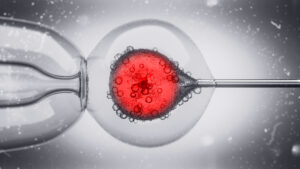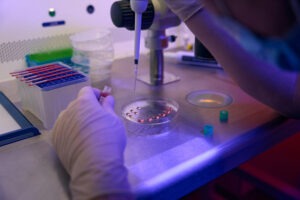The IVF Revolution: A Journey of Innovation for Building Families
Introduction
In the realm of assisted reproductive technology, In Vitro Fertilization (IVF) stands as a beacon of hope for couples facing infertility. This remarkable journey, which began with a single scientific breakthrough, has evolved into a sophisticated field driven by relentless innovation. Today, with advancements like genetic testing, time-lapse imaging, and even the whispers of artificial intelligence, IVF is changing lives more effectively than ever before, helping countless families grow.

Let’s dive into the fascinating history of IVF, explore the cutting-edge technologies transforming the process, and glimpse into the future where continued innovation promises to make the dream of parenthood a reality for even more people.
A Brief History of IVF: From Humble Beginnings to Global Impact
- The Early Days: The world’s first “test-tube baby,” Louise Brown, was born in 1978 – a watershed moment in reproductive medicine. Early IVF procedures were undeniably simpler, with less focus on individual embryo selection and more reliance on transferring multiple embryos to increase the chances of success.
- Gaining Momentum: The 1980s and 90s saw the rise of specialized IVF clinics, refinements in medication protocols, and greater public awareness and acceptance. Success rates steadily improved, but remained a significant hurdle for many patients.
- The 21st Century Boom: As the new millennium dawned, IVF became increasingly precise. Techniques like ICSI (Intracytoplasmic Sperm Injection), where a single sperm is directly injected into the egg, tackled even challenging cases of male infertility. Success rates climbed across all age groups, and IVF became a beacon of hope for a wider range of patients.
Key Advancements Transforming the IVF Landscape
Let’s delve into the groundbreaking technologies and cutting-edge techniques that are giving hopeful parents a better chance at building their families:
-
Preimplantation Genetic Testing (PGT): The Power of Healthy Choices
- Before an embryo is transferred, PGT can screen for chromosomal abnormalities (PGT-A) or specific inherited genetic conditions (PGT-M).
- This helps doctors and patients select the healthiest embryos, boosting success rates while also reducing the risk of miscarriage, genetic disorders, and the emotional toll of multiple failed cycles.
- PGT, while once considered somewhat controversial, is now becoming a standard part of the IVF process for many patients, offering unparalleled peace of mind and informed decision-making.
-
Time-Lapse Embryo Imaging: A Window into Development
- Traditional IVF involves brief, periodic checkups on embryos after removing them from the incubator, potentially causing subtle changes in temperature and pH that can cause stress.
- Time-lapse systems, like the Embryoscope, Geri or Miri, have built-in cameras and microscopes, taking snapshots of embryo development constantly without disruption.
- Embryologists gain a wealth of data, allowing them to select the most promising embryos based on their growth patterns, timing of key milestones, and overall morphological quality. It’s like having a 24/7 reality show of those first critical days of life, giving insights impossible to gather manually.

-
Ovarian Tissue Cryopreservation: Protecting Future Fertility
- For women facing cancer treatment or other medical procedures that could permanently damage their ovaries, this option offers incredible hope for biological children later in life.
- A sliver of ovarian tissue, containing thousands of immature eggs, is carefully frozen before treatment begins.
- If the patient is cancer-free later on, the tissue can be re-implanted. In some cases, this restores natural fertility, while in others, those frozen eggs can be used for IVF.
-
Improved Culture Media: A Nurturing Environment
- Embryos in the IVF lab spend several crucial days outside the body, and the fluids used to support them now closely mimic the conditions of the fallopian tube.
- Researchers have painstakingly fine-tuned the balance of nutrients, hormones, proteins, and other factors in culture media, leading to healthier embryos and a better chance of a successful pregnancy.
-
Artificial Intelligence (AI) and Machine Learning: The Smart Assistants
- AI can analyze massive datasets – patient medical histories, detailed embryo images, and past IVF results – to find patterns invisible to the human eye.
- This may lead to even more personalized treatment plans, better embryo selection, and ultimately increased success rates for a wider range of patients.
- Examples like the KIDScoreD5 system and ERICA demonstrate that AI-assisted embryo assessment is not just science fiction, but a tool that can potentially improve IVF outcomes today.

-
Egg Freezing Techniques: Expanded Options
- Vitrification, a flash-freezing method using specialized solutions, has revolutionized egg freezing (oocyte cryopreservation).
- Younger eggs offer a better chance of success. This gives women greater control over their fertility timeline due to social reasons, medical conditions like endometriosis, or simply wanting to focus on other goals for a few years without the pressure of their biological clock.
-
Single Embryo Transfer (SET): Safety and Success
- In the past, transferring multiple embryos to increase chances was common, leading to high rates of twins and triplets, carrying risks for both mother and babies.
- With modern advancements leading to more accurate embryo selection, SET is the new standard – one healthy embryo can often lead to a full-term, healthy pregnancy, minimizing the potential for complications.

The Future of IVF: Where the Innovation Will Lead
While these advancements are incredible, the IVF field is characterized by a continuous drive for improvement. Here’s a glimpse of what might lie ahead:
- AI-Powered Embryo Analysis: Imagine software that spots subtle growth patterns the most experienced embryologist could miss. This could further refine embryo selection, leading to even higher success rates.
- Beyond the Dish: Non-Invasive Assessment Could we analyze what embryos secrete into the culture media to judge their health without a biopsy? Early-stage research, but a fascinating prospect that could avoid unnecessary risks.
- Fertility Access: Might there be simpler, more affordable IVF options in the future, expanding who can benefit from this technology? Innovations like in-home embryo monitoring could streamline the process, reducing costs.
- The Next Frontiers: Research into editing problematic genes, creating artificial wombs and developing eggs and sperm from stem cells push boundaries. While ethically complex, these could one day offer solutions for the most challenging infertility cases.
FinDBest IVF: Partnering for IVF Innovation
This constant evolution in the IVF field presents both opportunities and challenges. Finding the right partners is essential for manufacturers and healthcare providers to ensure patients have access to the latest advancements. That’s where we come in:
- Niche Expertise: IVF and ART are our focus. We connect you with distributors who deeply understand the complexities of this market.
- Embracing the Cutting Edge: We work with clinics hungry for innovation, who want to offer their patients the very best.
- Global Reach: Whether you need regulatory experts in a new market or want to be first to market with the next big tech, we’ll find the right partners!
- Connecting the Dots: Spark Productive Partnerships: Navigating the ever-changing IVF landscape can be time-consuming. We help you connect with the ideal distributors and clinics at industry events and conferences most relevant to your target markets.
Ready to shape the future of IVF? Visit FinDBest IVF today!






